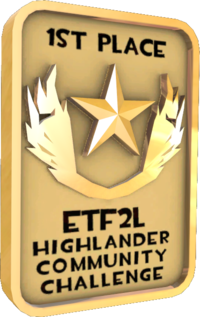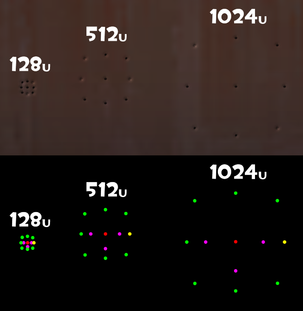Difference between revisions of "Highlander (Competitive)"
m |
m |
||
| Line 24: | Line 24: | ||
Random [[Critical hits|crits]] are disabled. | Random [[Critical hits|crits]] are disabled. | ||
| − | All non-random crits still function, so long as their status is relevant (for example, [[backstab]]s will not crit, but still deal 600% of the target's current hit points | + | All non-random crits still function, so long as their status is relevant (for example, [[backstab]]s will not crit, but still deal 600% of the target's current hit points). |
==Damage Spread== | ==Damage Spread== | ||
Revision as of 19:19, 14 December 2013
- This article is for competitive play.
The standard competitive format Highlander is the common rule set used by the largest and most serious TF2 leagues. Not all leagues follow all of these rules exactly, but most major ones do, and most competitive players scrim with them on. Settings not listed here are either default, don't impact gameplay options, or significantly vary by league.
Most who play in leagues that follow the standard competitive format use the standard competitive lineup.
Contents
Team Sizes
Teams are limited to 9 players each. Most leagues allow teams to start with 8 players if they are unable to field a nine (though it is common practice to give opponents extra time to find all of their players necessary are having trouble). Teams unable to field more than nine players generally incur a forfeit loss.
Class Limits
Classes are limited as follows:
Criticals
Random crits are disabled.
All non-random crits still function, so long as their status is relevant (for example, backstabs will not crit, but still deal 600% of the target's current hit points).
Damage Spread
Damage spread is disabled.
This means that damage randomization is removed, but damage ramp-up and falloff based on distance still occurs.
Weapon Spread
Fixed weapon spread is enabled.
This means that pellet-style weapons (Shotgun, Scattergun, Force-A-Nature, Shortstop) fire pellets in a nonrandom pattern. The pattern is composed of 9 hitscan paths spaced like a 3x3 grid, with one extra pellet going down the center (or, for the Force A Nature, two extra going down the center and one extra going down the middle-right path).
Stopwatch
Attack-defend maps use stopwatch.
This means that if both teams capture the same number of points when on offense, the team that did so faster wins that round.
Timed CTF
CTF matches are played to a specific time limit (as opposed to score goal, though there may be a mercy rule).
This means that a given half of a match will continue playing until the timer runs out. Most leagues tally points from all halves into final scores (assuming there is more than one half) to determine the winner. Some leagues enact mercy rules, which end the game early if one team gets an insurmountable point lead over the other. Crits on capture is disabled.
Teamtalk
Teamtalk, if specified at all, is enabled.
This means that team members can use in-game voice and text chat with each other even while dead (though most teams use external voice programs like Mumble regardless). Unfair ghosting is prevented by only allowing dead players to spectate allies, with third-person and free-roam spectating disabled.
Customization
All game models, textures, and particles are forced to TF2 defaults via sv_pure 2.
The wait command may or may not be disabled. Scripts otherwise function normally and are permitted, so long as they're not exploitative.
Custom HUDs are allowed in full.
| |||||||||||||||||||||||||||||||

